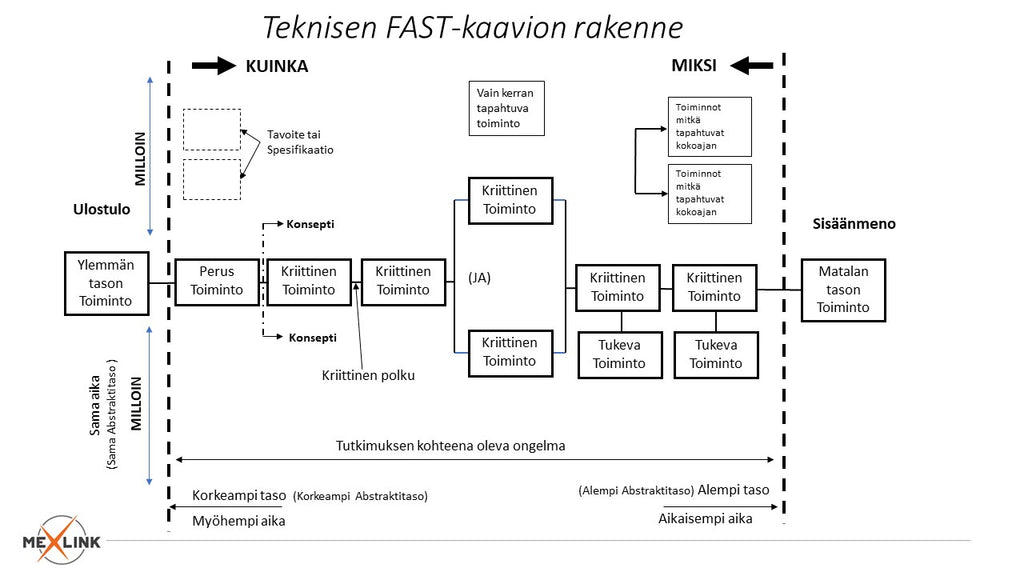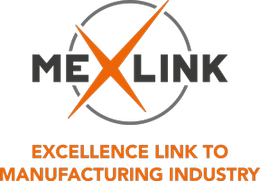Function Analysis System Technique 1 (Function Analysis System Technique, FAST) by Pentti Enlund
Posted by PASI JULKUNEN

Function Analysis 1 (Function Analysis System Technique, FAST)
Functional analysis of a product or process Part 1
Better known as Function Analysis System Technique, FAST
The expectations of the customer (customer segment) for the purchased product
The two previous articles ( https://www.mexlink.fi/pearls/21l95rf5v71id8ptes6xxyqmtqllsu ) and https://www.mexlink.fi/pearls/arvoanalisi-ja-kustannussuunnittu ) dealt with customer needs and their priority and the stages of the VA/VE process. From them, the goals and their connection to technical solutions are clearly prioritized. Now we need ways to reach the goals.
Often the identified cost problems are too big and extensive to deal with at once. Therefore, the problem field to be dealt with must be divided into smaller sub-areas, better manageable entities.
Selectable object of examination and data collection
A measurable object must be chosen as the target. The selected target can be measured, e.g., by improvement of operations, timely response, cost-based, etc. Listing all the factors affecting costs is very important in the VA/VE process, because it helps the design team e.g. when performing functional analysis. Such factors include, for example, material information, warranty information, costs of own production, amount of scrapping and repair, process flow analysis, video recording of the process, names of parts, quantities, material costs, labor costs, number of pieces, etc.
Once this information is collected, the team records all the parts, the process description and costs, in the Cost-Activity worksheet. This phase is one of the most important work phases because it describes the union of cost and function, the most important aspect of the VA/VE process.
One work tool for data collection , Reverse Engineering, may sound exotic, but it is extremely important, especially in a competitive situation, where companies compete directly on price, quality and the number of product functions. Such a competitive environment occurs, for example, in large-volume work machines (excavators, loading machines, bulldozers and tractors), household appliances (refrigerators, stoves, ovens, mixers, hair dryers, coffee makers, irons, TVs, etc.) and, of course, in the automotive industry. This kind of competitive situation is called the strategy of meeting the competition .
Finnish industry is already drifting and has partly found itself in such a situation. It is therefore essential to know how to analyze competitors' costs and what they consist of, as well as what can be learned from them. I will deal with this aspect later as its own story.
Product functions
All the costs needed to make a product should produce some function. The customer usually only wants two types of functionality for a product or service: Usability and Aesthetics functionality.
An usability function is a function that the customer wants in order for some higher-level function to be performed. For example, an image projector for educational use is bought so that an image or text can be projected onto the wall, but the higher-level function is to teach students using the projected image.
The aesthetic function pleases the user. This category includes e.g. perfume/shaving water, art, diamonds, work machine covers, industrial design products, colors, compositions, etc. It is left to the reader to think about what is the higher-level function that is intended to be achieved by using perfume.
Many products perform both functions at the same time, for example kitchen appliances, car hood or mask, furniture, clothes and work machine covers. On the other hand, water pipes, nails and the various liquids used in the work machine only perform one function.
The language of operations
Traditional cost reduction techniques ask, "How can we reduce the cost of the product?". VA/VE technology first asks: "What does the product do?" and next: "How can we achieve the same things better and with fewer activities?". A functional approach to a product or the process that produces it is to ask: "What does something do or must do?" .
The language of operations provides a simple and understandable communication tool so that people with different backgrounds and education can communicate clearly and precisely with each other.
Therefore, the language is standardized both for the product itself and for the production process that makes it. Language is divided into Verbs and Nouns in both categories. The functions of the product are defined by them.
This offers the following benefits:
· Terminology is simplified
· Enables a better and deeper understanding of the subject under review
· Is broad and general, giving room for creativity
· A noun is chosen so that it has measurable properties
Everyday language vs. functional language, examples:
Everyday language The language of operations
· The shaft turns the wheel The shaft transmits torque
· The electric motor i rotates the wheel The electric motor produces torque
· The bulb illuminates the room The bulb produces light
· The fuel tank contains fuel The fuel tank maintains volume
That is, as broad and general a description as possible expressed by a measurable quantity.
Identifying functions
The first task is to express precisely and clearly what the product does, using the language of functions. A properly performed function analysis tells:
· Exactly what the product does for the customer
· Exactly what the customer wants the product to do
· Exactly what the customer is paying for
Next, name the product to be designed, the sub-area under review, the function of each individual part and its meaning in the system under review, expressed by a Verb and a measurable Noun. The functions of the product and the stages of the manufacturing process are described by forming a function hierarchy, which is called a Function Analysis. Figure 1 shows the structure of the function analysis.
FAST Diagram https://youtu.be/S1FV-SR9hxs
Naming the function of each part is to challenge the people working on the analysis to see inside the function. This requires even experienced product designers to rethink the root causes of functions.
Because accurately naming functions is a demanding task, many people prefer to abandon the entire process before it is complete. However, it can be said here that often there is no shortcut to happiness, it requires work. Fortunately, the same functions are repeated in other products, so the basic work done always benefits the future.
In the next part of the functional analysis, I will discuss the different functions in more detail, as well as the analysis itself, how it is done. These are not just theories, but the procedure in question has been used to successfully reduce costs and increase customer value.
Pentti Enlund
MexLink Oy
 English
English Finnish
Finnish Swedish
Swedish German
German


